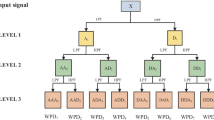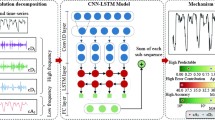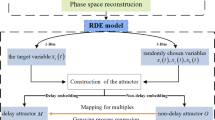Abstract
Accurately predicting runoff is crucial for managing water resources, preventing and mitigating floods, scheduling hydropower plant operations, and protecting the environment. The hydrological dynamic composite system that forms runoff is complex and random, and seemingly random behavior may be caused by nonlinear variables in a simple deterministic system, which poses a challenge to runoff prediction. In this paper, we construct parallel and multi-timescale reservoirs from a chaotic theory perspective to simulate the stochasticity of chaotic systems. We propose a multi-task-based "Decomposition-Integration-Prediction" (Multi-SDIPC) model for runoff prediction. To validate our research results, we use the Catchment Attributes and Meteorology for Large-Sample Studies (CAMELS) dataset and compare our proposed model with 10 baseline models. The results show that our model has an average NSE metric of 0.83 and exhibits higher accuracy, better generalization, and greater stability than the other models in multi-step forecasting. Based on our findings, we recommend wider application of the Multi-SDIPC model in different regions of the world for medium or long-term runoff prediction.











Similar content being viewed by others
Data Availability
The data that support the findings of this study are openly available in Hydrology and Earth System Sciences at https://doi.org/10.5194/hess-21-5293-2017, 2017.
References
Addor N, Newman AJ, Mizukami N, Clark MP (2017) The camels data set: catchment attributes and meteorology for large-sample studies. Hydrol Earth Syst Sci 21(10):5293–5313. https://doi.org/10.5194/hess-21-5293-2017
Adnan RM, Mostafa RR, Kisi O, Yaseen ZM, Shahid S, Zounemat-Kermani M (2021) Improving streamflow prediction using a new hybrid elm model combined with hybrid particle swarm optimization and grey wolf optimization. Knowl-Based Syst 230:107379. https://doi.org/10.1016/j.knosys.2021.107379
Arcomano T, Szunyogh I, Pathak J, Wikner A, Hunt BR, Ott E (2020) A machine learning-based global atmospheric forecast model. Geophys Res Lett 47(9):e2020GL087776. https://doi.org/10.1029/2020GL087776
Cosgrove BA, Lohmann D, Mitchell KE, Houser PR, Wood EF, Schaake JC, Robock A, Marshall C, Sheffield J, Duan Q, Luo L, Higgins RW, Pinker RT, Tarpley JD, Meng J (2003) Real-time and retrospective forcing in the north american land data assimilation system (nldas) project. J Geophys Res Atmos 108(D22). https://doi.org/10.1029/2002JD003118
Cui Z, Chen W, Chen Y (2016) Multi-scale convolutional neural networks for time series classification. CoRR abs/1603.06995
Gao S, Huang Y, Zhang S, Han J, Wang G, Zhang M, Lin Q (2020) Short-term runoff prediction with GRU and LSTM networks without requiring time step optimization during sample generation. J Hydrol 589:125188. https://doi.org/10.1016/j.jhydrol.2020.125188
Giri F, Devercelli M (2023) Chaos arising from the hydrological behaviour of a floodplain river during the last century. River Res Appl 39(2):241–254. https://doi.org/10.1002/rra.4080
Griffith A, Pomerance A, Gauthier DJ (2019) Forecasting chaotic systems with very low connectivity reservoir computers. Chaos: An Interdisciplinary Journal of Nonlinear Science 29(12). https://doi.org/10.1063/1.5120710
Gupta V, Li LK, Chen S, Wan M (2023) Model-free forecasting of partially observable spatiotemporally chaotic systems. Neural Netw 160:297–305. https://doi.org/10.1016/j.neunet.2023.01.013
Han M, Zhang S, Xu M, Qiu T, Wang N (2019) Multivariate chaotic time series online prediction based on improved kernel recursive least squares algorithm. IEEE Trans Cybern 49(4):1160–1172. https://doi.org/10.1109/TCYB.2018.2789686
He R, Zhang L, Chew AWZ (2022) Modeling and predicting rainfall time series using seasonal-trend decomposition and machine learning. Knowl-Based Syst 251:109125. https://doi.org/10.1016/j.knosys.2022.109125
He X, Luo J, Li P, Zuo G, Xie J (2020) A hybrid model based on variational mode decomposition and gradient boosting regression tree for monthly runoff forecasting. Water Resources Management: An International Journal, Published for the European Water Resources Association (EWRA) 34(2):865–884. https://doi.org/10.1007/s11269-020-02483-x
Jaeger H (2001) The “echo state’’ approach to analysing and training recurrent neural networks-with an erratum note. Bonn, Germany: German National Research Center for Information Technology GMD Technical Report 148(34):13
Kratzert F, Klotz D, Brenner C, Schulz K, Herrnegger M (2018) Rainfall-runoff modelling using long short-term memory (lstm) networks. Hydrology and Earth System Scviences 22(11):6005–6022. https://doi.org/10.5194/hess-22-6005-2018
Li BJ, Sun GL, Liu Y, Wang WC, Huang XD (2022) Monthly runoff forecasting using variational mode decomposition coupled with gray wolf optimizer-based long short-term memory neural networks. Water Resour Manage 36(6):2095–2115. https://doi.org/10.1007/s11269-022-03133-0
Ma Q, Chen E, Lin Z, Yan J, Yu Z, Ng WWY (2021) Convolutional multitimescale echo state network. IEEE Trans Cybern 51(3):1613–1625. https://doi.org/10.1109/TCYB.2019.2919648
Malakoutian MMA, Samaei SY, Khaksar M, Malakoutian Y (2022) A prediction of future flows of ephemeral rivers by using stochastic modeling (ar autoregressive modeling). Sustainable Operations and Computers 3:330–335. https://doi.org/10.1016/j.susoc.2022.05.003
Maurer EP, Wood AW, Adam JC, Lettenmaier DP, Nijssen B (2002) A long-term hydrologically based dataset of land surface fluxes and states for the conterminous united states. J Clim 15(22):3237–3251. https://doi.org/10.1175/1520-0442(2002)015<3237:ALTHBD>2.0.CO;2
McKitrick R, Christy J (2019) Assessing changes in us regional precipitation on multiple time scales. J Hydrol 578:124074. https://doi.org/10.1016/j.jhydrol.2019.124074
Mohsin AKM, Hongzhen L, Iqbal MM, Salim ZR, Hossain A, Kafy AA (2021) Forecasting e-waste recovery scale driven by seasonal data characteristics: A decomposition-ensemble approach. Waste Manag Res 40:870–881. https://doi.org/10.1177/0734242X211061443
Pérez-Alarcón A, Garcia-Cortes D, Fernández-Alvarez JC, Martínez-González Y (2022) Improving monthly rainfall forecast in a watershed by combining neural networks and autoregressive models. Environ Process 9(3):53. https://doi.org/10.1007/s40710-022-00602-x
Sivakumar B (2000) Chaos theory in hydrology: important issues and interpretations. J Hydrol 227(1):1–20. https://doi.org/10.1016/S0022-1694(99)00186-9
Theodosiou M (2011) Forecasting monthly and quarterly time series using stl decomposition. Int J Forecast 27(4):1178–1195. https://doi.org/10.1016/j.ijforecast.2010.11.002
Thornton M, Shrestha R, Wei Y, Thornton P, Kao SC, Wilson B (2022) Daymet: Daily surface weather data on a 1-km grid for North America, version 4 r1
Tian Q, Gao H, Tian Y, Jiang Y, Li Z, Guo L (2023) Runoff prediction in the xijiang river basin based on long short-term memory with variant models and its interpretable analysis. Water 15(18). https://doi.org/10.3390/w15183184
Vlachas P, Pathak J, Hunt B, Sapsis T, Girvan M, Ott E, Koumoutsakos P (2020) Backpropagation algorithms and reservoir computing in recurrent neural networks for the forecasting of complex spatiotemporal dynamics. Neural Netw 126:191–217. https://doi.org/10.1016/j.neunet.2020.02.016
Xiang Z, Yan J, Demir I (2020) A rainfall-runoff model with lstm-based sequence-to-sequence learning. Water Resour Res 56(1): e2019WR025326. https://doi.org/10.1029/2019WR025326
Xu Z, Zhou J, Mo L, Jia B, Yang Y, Fang W, Qin Z (2021) A novel runoff forecasting model based on the decomposition-integration-prediction framework. Water 13(23). https://doi.org/10.3390/w13233390
Yaseen ZM, Sulaiman SO, Deo RC, Chau KW (2019) An enhanced extreme learning machine model for river flow forecasting: State-of-the-art, practical applications in water resource engineering area and future research direction. J Hydrol 569:387–408. https://doi.org/10.1016/j.jhydrol.2018.11.069
Yin H, Wang F, Zhang X, Zhang Y, Chen J, Xia R, Jin J (2022) Rainfall-runoff modeling using long short-term memory based step-sequence framework. J Hydrol 610:127901. https://doi.org/10.1016/j.jhydrol.2022.127901
Yu D, Guobin Xu YW, Yang D (2020) The middle huaihe river stability analysis and optimization of hydrological chaos forecasting model. Geomat Nat Haz Risk 11(1):1805–1826. https://doi.org/10.1080/19475705.2020.1815870
Yu-tong Z, Xiao-min W, Ting L (2019) Characteristic analysis and prediction of runoff based on chaotic wavelet neural network. In 2019 Chinese Control And Decision Conference (CCDC), pp. 1765–1769
Zhang Y, Yang Q (2017) 09. An overview of multi-task learning. Natl Sci Rev 5(1):30–43. https://doi.org/10.1093/nsr/nwx105
Zhou T, Wen X, Feng Q, Yin Z, Yang L (2022) Research on runoff prediction of shule river based on bma multiple model combination. J Glaciol Geocryol 44(5):1606. https://doi.org/10.7522/j.issn.1000-0240.2022.0141
Zhou Z, Dong X (2012) Analysis about the seasonality of china’s crude oil import based on x–12-arima. Energy 42(1):281–288. https://doi.org/10.1016/j.energy.2012.03.058
Funding
This work was supported by the National Natural Science Foundation of China (61973226, 62003233), the Shanxi Provincial Department of Water Resources 2023 Water Technology Research and Promotion Subsidy Projects(2023GM17), the Shanxi Province Major Special Program of Science and Technology “Unveiling and Commanding“ Project(202201090301013), the Natural Science Foundation of Shanxi Province(202203021222101).
Author information
Authors and Affiliations
Contributions
Hui Zuo: conceptualization, methodology, software, visualization, formal analysis, writing-original draft preparation. Gaowei Yan: conceptualization, methodology, writing-review and editing, supervision, funding acquisition. Ruochen Lu: supervision, software, writing-review & editing. Rong Li: conceptualization, methodology, writing-review & editing. Shuyi Xiao: conceptualization, methodology writing-review & editing. Yusong Pang: conceptualization, supervision, Writing-review & editing.
Corresponding author
Ethics declarations
Ethics Approval
This paper does not contain any studies with human participants or animals performed by any of the authors.
Consent to Participate
Consent.
Consent for Publication
Consent.
Conflict of Interest
The authors declare no competing interests.
Additional information
Publisher's Note
Springer Nature remains neutral with regard to jurisdictional claims in published maps and institutional affiliations.
Rights and permissions
Springer Nature or its licensor (e.g. a society or other partner) holds exclusive rights to this article under a publishing agreement with the author(s) or other rightsholder(s); author self-archiving of the accepted manuscript version of this article is solely governed by the terms of such publishing agreement and applicable law.
About this article
Cite this article
Zuo, H., Yan, G., Lu, R. et al. A Multi-Task Learning Based Runoff Forecasting Model for Multi-Scale Chaotic Hydrological Time Series. Water Resour Manage 38, 481–503 (2024). https://doi.org/10.1007/s11269-023-03681-z
Received:
Accepted:
Published:
Issue Date:
DOI: https://doi.org/10.1007/s11269-023-03681-z




